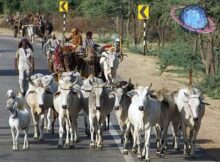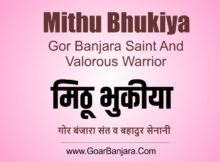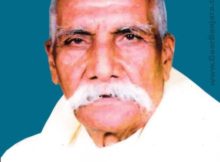Clothing
The male’s outfit includes Dhoti, Barabundi (Shirt & Coat), Uparana and a Turban. The style of clothing of Banjara women is quite different and attractive. They normally wear a ghaghra (stretching up to knees), which is hand-woven, and a blouse. A cloth covers the head.
This pattern is in practice since thousands of years without a change and that is why Banjara women are unique compared to women of other tribes. Her clothing style is a symbol of an art-loving and skilled craftsmanship. The design work done on Ghaghra, Blouse and the head cloth is highly artistic. An international exhibition of weaving works was held in 2001.
Eight Banjara women of Yallamma Tanda from Andhra Pradesh got a prize of 1500 dollars (then 60 thousand rupees) for their weaving works. This is an ample proof of the richness of their weaving styles on clothing. References about presence of these clothing styles are found in Indus culture.
Hair Styles
Both the Gor Banjara men and women have a penchant for hairstyles. Men grow long hair below the ear and make a specific pattern. It is called as Zalpa. Men take pride in growing a hair-tail and preserve it. The old Banjara men still maintain this traditional hairstyle.
Gor woman also styles her hair in a unique and attractive manner. She divides the hair in two equal halves and engages them on both the cheeks in ‘Ghugari Topali.’ While the portion of the pony tail at the back is engaged in ‘Shing Aati.’ A terracotta figure showing such a hairstyle has been found at Harappa.
Ornaments
The Gor Banjara men wear a metal ring in the wrist, a big ring in ear and silver string on the waist. While Gor woman is so obsessed with ornaments that she wears different types of ornaments weighing 10 to 15 KG on her person. Normally they are made up of copper, zinc, silver, ivory rings, munga, glass, shells, mercury and necklaces.
The excavations at Harappa have revealed all such ornaments, which are used by the Gor Banjara women even today. On the basis of her ornaments and clothing it can be understood whether the woman is unmarried, married or a widow. A married woman wears Ghughri, Wakadi and Chudiya (bangles). She does not apply vermilion on her forehead. She tattoos her body and places a horn in her hair with pride, which is a sacred symbol of Gor Vamsha.
Gor woman is the only one in the world to don a horn of ox on her head. The ox, which is fore bringer of prosperity to Gor Banjaras, is highly regarded as sacred and worshipped. In the marriage ceremony the bride is presented with an ox and is given farewell by making her sit on the ox. Perhaps this is a unique ritual still traditionally performed in some of the Tandas.
Dialect
Gorvamshiyas have an independent dialect. It is known as Gor Boli or Gormati Boli. This dialect is still spoken since pre-Indus period in Gor provinces of Afghanistan, Baluchistan, Sindh, Punjab, Rajasthan, Gujarat, Kathewad, Harappa and Mohenjodaro.
This belt is regarded as the original region of Indus culture. If we make a comparative study of the Gor dialect spoken in India and the above-mentioned tribal belt then it can be said that the Gor dialect might have been the original dialect. Further various languages might have originated from the Gor dialect. Any language originates from two or three dialects.
The language spoken by Gypsy Roma falls in the category of Indo-Aryan language. Today the Gor Banjaras in India speak in the Gor dialect. The local languages did have an impact on the Gor dialect. Still they have maintained the original Gor dialect.
The Gor Banjara woman is mostly credited for keeping alive the dialect. She speaks with any other person in her dialect only. She thinks that others also know the Gor dialect. Her persistence that others should understand her language has kept the dialect alive.
The characteristic of the Gor dialect lies in the fact that even though other languages affect its pronunciations still the original meaning of the words have not changed. That is why a Gor Banjara person form any province can speak in his Gor dialect with other members of his clan.
Script
There must have been an independent script for Gor dialect. Its origin can be traced through the symbols found in the Indus excavations. Small 396 letter signs have been found regarding the Indus script. Experts have still not been able to decipher these signs. Shri. P. R. Deshmukh did make an effort in this direction but the complete script still remains a mystery.
According to the script experts there might have been in independent script prior to Indus civilization. Excavation of an Ink Pot suggests that the material on which the literature was prepared might have been perishable in nature. If the letter signs found in Indus civilization are deciphered then one day the Gor script can also be found. References of Kharaushti, Brahmi are found in 3rd Century BC; the Gor script might be their original script.
Literature
The literature of Gor Banjara is rich with folklores, songs, music etc. Their rich interests, civilized nature and culture are reflected in their folk literature. Numerous references can be found in the folk literature, which prove that Gorvamshi tribe was a progressive one in all respects. References about education for the new generation, personal development and social life etc. are found in the folk songs. The Sumerian, Greek and Gor cultures are 90% identical. Also the Greek folklores and Gor folklores have lot of similarities. The folklore of King Oedipus Rex is identical to that present in Gor Banjara folklores.
Banjara women through the folk songs sing folklores about destiny and the depiction of future by a witch, lore of Zamari Zamali. If a comparative study about folk rituals, life, literature, language, clothing etc. of contemporary civilizations during Indus period is done then the Gor culture will also prove its prominence.









